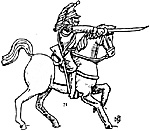
GAME 2
Jonathan Aird, Russian 1813. Objectives: capture the river crossings.
Ian Dickman, French 1813. Objectives: capture the river crossings.
The two commanders decided on a very different approach to the battle; the Russian commander split his forces into two, with over half his army on the left tasked to capture the two fords and his 2nd Infantry Division on the right ordered to capture the bridge. The French commander deployed his whole army on the right, opposite the fords.
The Russian 2nd Division, therefore, was able to march unmolested to the bridge and deploy to defend it. Even later, when the sounds of battle from the other flank reached a crescendo and his subordinates urged him to march to the sound of the guns, the divisional commander stuck steadfastly to his orders and remained in place.
The French stole a march on their opponents and moved off first, the cavalry division riding down the road and the three infantry divisions advancing in a line. By coincidence, the Russian cavalry also advanced via the road. The French became aware of the approaching enemy first, and deployed to receive them. Their attached horse artillery battery unlimbered. The Russians followed suit, but with orders to engage enemy horse, they were obliged to charge. The attack was disastrous for the Russian Uhlan regiment, which was scattered by the French cuirassier regiment opposing it, but the remainder of the melee was inconclusive and the two sides fell back to regroup.
As the cavalry re-ordered, the French 1st infantry division reached the crest of the hill adjacent to the road. Becoming aware of the Russian cavalry, they unlimbered their artillery and sent skirmishers to harass the Russian flanks. To their left, 2nd Division advanced through the gap between the hills, with 3rd Division mounting the hill in the centre of the battlefield. The Russian 1st Division were also advancing, and also heading for the gap between the hills.
The opposing infantry divisions, Russian 1st and French 2nd, soon came into musket range. Five French battalions in the first line opposed six Russian.
However, the Jager brigade on the right of the 1st Divisionís line also came under fire from guns and skirmishers from the French 3rd Division. The two battalions of Infantry Legere facing them formed attack columns and charged. The Jagers were caught wrong footed, broke, and ran.
Thus far, everything had gone the French armyís way. This was soon to change.
The Russian Division included a strong artillery component, which had formed in grand battery on their left. The French 1st Division was thus directly in front of them on their hill, halted to avoid baring their flank to the Russian cavalry. The Russian guns had a field day, blasting great holes in the ranks of a 3-battalion regiment of conscripts. The Russian 2nd Brigade, of 4 battalions, which had been held up as the artillery crossed its front, now arrived. Two battalions joined the fire combat against the French 2nd Division, but the other two charged the shaken conscripts. The French did not wait to receive them, but fled in panic. A veteran French regiment moved up to fill the gap, held the Russian attack, but then in their turn ground to a halt before the terrible line of guns.
In the centre, casualties were mounting on both sides. A French conscript regiment melted away, battalion by battalion, while their Russian counterparts closed their ranks around their colours and filled in the gaps torn by musketry.
Climax was reached first on the Russian left. Their cavalry, plagued by superior numbers of enemy guns, charged in desperation. Unnerved by flanking fire, they were speedily defeated and routed. Their accompanying battery hurriedly limbered and escaped the rout.
The French 1st Division was now able to advance, lapping round the Russian flank. Two battalions of light infantry charged the great line of guns from the side, bayoneting any gunners who were not swift enough to take to their heels. But the artillery had done its work well; the battered French veterans on the hill were charged by Russian infantry and, like their conscript comrades, broke and fled.
The two 1st Divisions, French and Russian, had now had enough. Both of them had lost over half their units broken. Each disengaged and fell back, retiring from the battlefield.
The remaining French units were now able to advance. A reserve Russian division, of 4 battalions, had been left to guard the ford, but they were heavily outnumbered and outflanked and they too were soon forced to retire, leaving the French in control of both fords.
| Point Source | Russian | French |
|---|---|---|
| Casualties | 11 | 9 |
| Captured colors | 20 | 10 |
| Captured guns | 8 | 24 |
| Objectives | 10 | 10 |
| Total | 49 | 53 |
(Phew! I was exhausted after this battle. What a punch-up!)
[For more details on the Tournament Battles run by Chris see previous editions of Lone Warrior. Kenn]
Back to Table of Contents -- Lone Warrior #134
Back to Lone Warrior List of Issues
Back to MagWeb Magazine List
© Copyright 2001 by Solo Wargamers Association.
This article appears in MagWeb (Magazine Web) on the Internet World Wide Web.
Other military history articles and gaming articles are available at http://www.magweb.com
